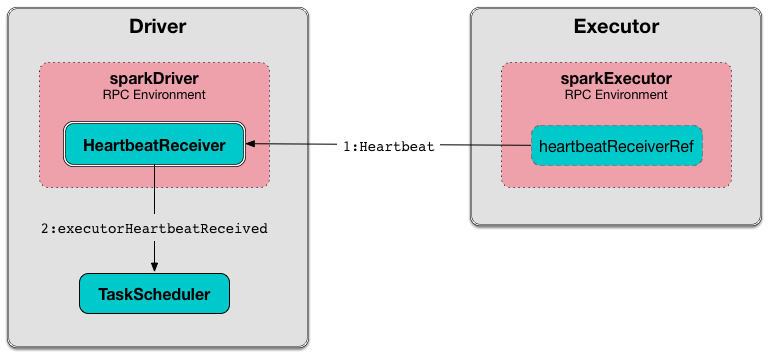
HeartbeatReceiver RPC Endpoint
HeartbeatReceiver is a ThreadSafeRpcEndpoint registered on the driver under the name HeartbeatReceiver.
HeartbeatReceiver receives Heartbeat messages from executors that Spark uses as the mechanism to receive accumulator updates (with task metrics and a Spark application’s accumulators) and pass them along to TaskScheduler.

|
Note
|
HeartbeatReceiver is registered immediately after a Spark application is started, i.e. when SparkContext is created.
|
HeartbeatReceiver is a SparkListener to get notified when a new executor is added to or no longer available in a Spark application. HeartbeatReceiver tracks executors (in executorLastSeen registry) to handle Heartbeat and ExpireDeadHosts messages from executors that are assigned to the Spark application.
| Message | Description |
|---|---|
Posted when |
|
Posted when |
|
Posted when |
|
Posted when |
| Name | Description |
|---|---|
Executor ids and the timestamps of when the last heartbeat was received. |
|
|
Tip
|
Enable Add the following line to Refer to Logging. |
Creating HeartbeatReceiver Instance
HeartbeatReceiver takes the following when created:
HeartbeatReceiver registers itself as a SparkListener.
HeartbeatReceiver initializes the internal registries and counters.
Starting HeartbeatReceiver RPC Endpoint — onStart Method
|
Note
|
onStart is part of the RpcEndpoint Contract
|
When called, HeartbeatReceiver sends a blocking ExpireDeadHosts every spark.network.timeoutInterval on eventLoopThread - Heartbeat Receiver Event Loop Thread.
ExecutorRegistered
ExecutorRegistered(executorId: String)When received, HeartbeatReceiver registers the executorId executor and the current time (in executorLastSeen internal registry).
|
Note
|
HeartbeatReceiver uses the internal Clock to know the current time.
|
ExecutorRemoved
ExecutorRemoved(executorId: String)When ExecutorRemoved arrives, HeartbeatReceiver removes executorId from executorLastSeen internal registry.
ExpireDeadHosts
ExpireDeadHostsWhen ExpireDeadHosts arrives the following TRACE is printed out to the logs:
TRACE HeartbeatReceiver: Checking for hosts with no recent heartbeats in HeartbeatReceiver.Each executor (in executorLastSeen registry) is checked whether the time it was last seen is not longer than spark.network.timeout.
For any such executor, the following WARN message is printed out to the logs:
WARN HeartbeatReceiver: Removing executor [executorId] with no recent heartbeats: [time] ms exceeds timeout [timeout] msTaskScheduler.executorLost is called (with SlaveLost("Executor heartbeat timed out after [timeout] ms").
SparkContext.killAndReplaceExecutor is asynchronously called for the executor (i.e. on killExecutorThread).
The executor is removed from executorLastSeen.
Heartbeat
Heartbeat(executorId: String,
accumUpdates: Array[(Long, Seq[AccumulatorV2[_, _]])],
blockManagerId: BlockManagerId)When received, HeartbeatReceiver finds the executorId executor (in executorLastSeen registry).
When the executor is found, HeartbeatReceiver updates the time the heartbeat was received (in executorLastSeen).
|
Note
|
HeartbeatReceiver uses the internal Clock to know the current time.
|
HeartbeatReceiver then submits an asynchronous task to notify TaskScheduler that the heartbeat was received from the executor (using TaskScheduler internal reference). HeartbeatReceiver posts a HeartbeatResponse back to the executor (with the response from TaskScheduler whether the executor has been registered already or not so it may eventually need to re-register).
If however the executor was not found (in executorLastSeen registry), i.e. the executor was not registered before, you should see the following DEBUG message in the logs and the response is to notify the executor to re-register.
DEBUG Received heartbeat from unknown executor [executorId]In a very rare case, when TaskScheduler is not yet assigned to HeartbeatReceiver, you should see the following WARN message in the logs and the response is to notify the executor to re-register.
WARN Dropping [heartbeat] because TaskScheduler is not ready yet|
Note
|
TaskScheduler can be unassigned when no TaskSchedulerIsSet has not been received yet. |
|
Note
|
Heartbeats messages are the mechanism of executors to inform the Spark application that they are alive and update about the state of active tasks.
|
TaskSchedulerIsSet
TaskSchedulerIsSetWhen received, HeartbeatReceiver sets the internal reference to TaskScheduler.
|
Note
|
HeartbeatReceiver uses SparkContext that is given when HeartbeatReceiver is created.
|
onExecutorAdded Method
onExecutorAdded(executorAdded: SparkListenerExecutorAdded): UnitonExecutorAdded simply sends a ExecutorRegistered message to itself (that in turn registers an executor).
|
Note
|
onExecutorAdded is a part of SparkListener contract to announce that a new executor was registered with a Spark application.
|
Sending ExecutorRegistered Message to Itself — addExecutor Internal Method
addExecutor(executorId: String): Option[Future[Boolean]]addExecutor sends a ExecutorRegistered message (to register executorId executor).
|
Note
|
addExecutor is used when HeartbeatReceiver is notified that a new executor was added.
|
onExecutorRemoved Method
onExecutorRemoved(executorRemoved: SparkListenerExecutorRemoved): UnitonExecutorRemoved simply passes the call to removeExecutor (that in turn unregisters an executor).
|
Note
|
onExecutorRemoved is a part of SparkListener contract to announce that an executor is no longer available for a Spark application.
|
Sending ExecutorRemoved Message to Itself — removeExecutor Method
removeExecutor(executorId: String): Option[Future[Boolean]]removeExecutor sends a ExecutorRemoved message to itself (passing in executorId).
|
Note
|
removeExecutor is used when HeartbeatReceiver is notified that an executor is no longer available.
|
Stopping HeartbeatReceiver RPC Endpoint — onStop Method
|
Note
|
onStop is part of the RpcEndpoint Contract
|
When called, HeartbeatReceiver cancels the checking task (that sends a blocking ExpireDeadHosts every spark.network.timeoutInterval on eventLoopThread - Heartbeat Receiver Event Loop Thread - see Starting (onStart method)) and shuts down eventLoopThread and killExecutorThread executors.
killExecutorThread — Kill Executor Thread
killExecutorThread is a daemon ScheduledThreadPoolExecutor with a single thread.
The name of the thread pool is kill-executor-thread.
|
Note
|
It is used to request SparkContext to kill the executor. |
eventLoopThread — Heartbeat Receiver Event Loop Thread
eventLoopThread is a daemon ScheduledThreadPoolExecutor with a single thread.
The name of the thread pool is heartbeat-receiver-event-loop-thread.
expireDeadHosts Internal Method
expireDeadHosts(): Unit|
Caution
|
FIXME |
|
Note
|
expireDeadHosts is used when HeartbeatReceiver receives a ExpireDeadHosts message.
|